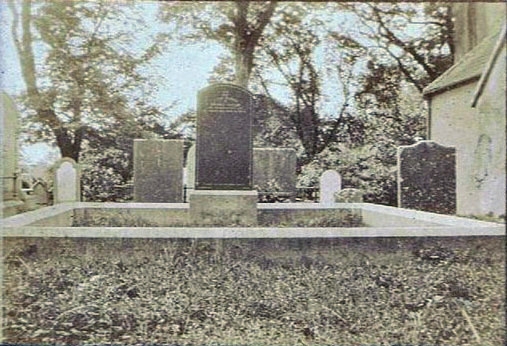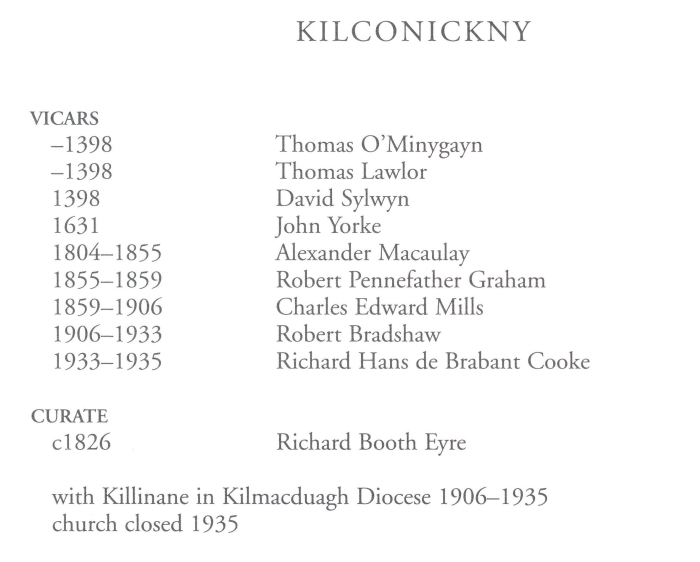Local history: using parish registers & gravestone inscriptions
In the latest of fascinating accounts on the value of exploring Church of Ireland parish registers, Gerry Kearney explores his approach to tracking parochial families in Killinane and Kilconickny in County Galway.
Killinane
Killinane, sometimes recorded as Killinan, was a vicarage in the diocese of Kilmacduagh. By order of the Privy Council dated 11 March 1726, Killinane was consolidated with the vicarages of Isertkelly, Kilchreest, Kilogollin (Killogilleen), Killora and Kilthomas to form what became known as the Killinane union. The Irish form of the name is Cill Fhionáin, meaning St Finan’s church, and surviving records of the clergy of the parishes of Killinane union date from c.1402.
In 1834, the total population of the union according to the census conducted by the Commissioners of Public Instruction was 9,149, and of that number, only 267 (2.9%) were Church of Ireland, or in the official language of the day: members of the ‘Established Church’. The church and graveyard of Killinane are situated south–west of Kilchreest, on the road from Loughrea to Gort, in the townland of Castleboy, between the great houses of the Persse families of Roxborough and Castleboy. Construction of the church was completed in c.1809 but the surviving gravestones indicate burials in the graveyard from at least 1786 suggesting an older building. It is possible that a nearby ruin of a former church may have been the church built by Dudley Persse (1625–1699) who requested that he be buried in the crypt beneath that church.

Unfortunately the early registers for the parish of Killinane were in the Public Records Office of Ireland in 1922, and were destroyed during the civil war. Registers lost included baptisms 1823–1881; marriages 1823–1844, and burials 1829–1881. Subsequent registers comprising baptisms 1882–1928; marriages 1845–1915 and burials 1883–1929, together with related parish records including the vestry minutes are now kept safe in the RCB Library.
Using these surviving records it is possible to glean a sense of the broad cross–section of parishioners: from the landed proprietors and staff employed in the great houses to farmers, merchants, professionals, tradespeople and labourers. Quite a number of the marriage and baptism records relate to members of the Royal Irish Constabulary, who were based in the barracks located in Kilchreest village.
The gravestones at Killinane graveyard help to supplement the surviving burial records, and fill in gaps in the early burial evidence. Each grave has a corresponding number on this locally produced sketch map:

Many of the gravestone inscriptions at Killinane include traditional passages from scripture, or, affectionate tributes from the bereaved. One which is of particular interest is the inscription on grave 49, the box–tomb of Parsons Persse of Castleboy estate. Parsons was an industrious landlord with a keen understanding of the commercial, political and social issues affecting the country. On his death in 1812, his will provided for the setting up of an endowment scheme to provide a school in the townland of Illerton for the children of his tenants. When the school closed, the funds were applied for the benefit of the four remaining schools within the boundaries of the Castleboy estate. While there are only two schools today (Kilchreest and Ballyglass National Schools) the Parsons Persse Endowment Scheme continues to support both. While the tomb of Parsons Persse is damaged and difficult to access, the inscription, is quite readable:
Herein are deposited the remains of the late
Parsons Persse of Castleboy Esq.
who departed this life
on the 6th of August 1812 aged
74 years
Impressed with feelings of gratitude and regret
which time can never diminsh
his son Robert has caused to be erected
this humble tribute of respect
to the memory of a Father’s virtue
In 1945 with falling numbers of parishioners, the church building at Killinane was closed. The former glebe house at Kilchreest was sold following the retirement of the last rector in 1935, but remains extant and privately occupied. Sadly Killinane church was demolished in the 1940s.
Kilconickny
The vicarages of Kilconiran, Kiltullagh and Lickerigg, were united to form Kilconickny union in 1735. The Irish form of the name is Cill C’nuicne, or Conicne’s church, and surviving records of the clergy of the parishes of Kilconickny union date from c.1398.

The total population of the union in 1834 was 8,806, of which only 130 (1.5%) were Church of Ireland. According to Nicholas Carlisle’s Topographical Dictionary of Ireland (1810) there was no church or glebe house in Kilconickny, but there was a glebe of five acres in the parish of Lickerrig and a glebe of two and a half acres in the parish of Kilconiran.
After disestablishment of the Church of Ireland it was suggested that Kilconickny union should be united with Killinane union and that it be served by a curate but such consolidation was resisted and the two unions were not united until the retirement of the Revd Charles Mills in 1906. The church at Bookeen closed in 1933 and having been used for a number of purposes it fell into considerable disrepair. However, it was acquired in 2006 by Chris Deakin and Orla McCluskey who then set about a sympathetic renovation of the building and the grounds, managing to salvage many of the original features in replicating the original design. The only surviving church records for Kilconickny is a single marriage register covering the period 1845–1907. This volume is safely lodged in the RCB Library.
Like Killinane, Kilconickny was united with Loughrea in 1945, and all are now part of the Aughrim union in the diocese of Clonfert.
To read a more detailed account by Gerry Kearney, click on the following link: http://ireland.anglican.org/about/128
Gerry Kearney is a native of Cloyne, County Cork and has lived in Oranmore, County Galway since 1989. He is married to Marguerite, nee Taylor, of Athenry and has three adult children. Gerry left school early and took up a clerical position with the Department of Posts and Telegraphs, now An Post, in 1969. He held a number of management positions including Head Postmaster at Carrick–on–Shannon, Sligo and Galway, and was the Retail Operations Manager for the Galway Area in 2011, when ill–health dictated that he retire earlier than planned.
Retirement provided the opportunity to re–kindle an interest in history, and Gerry self–published a family history in 2012 for limited circulation – The Taylor Family of Ardrahan Post Office, A History 1837–2012. In 2015, Gerry self–published The Church of Ireland Unions of Killinane and Kilconickny, Loughrea, County Galway – A History. Gerry is at present completing an extensive history of the Persse family of County Galway.